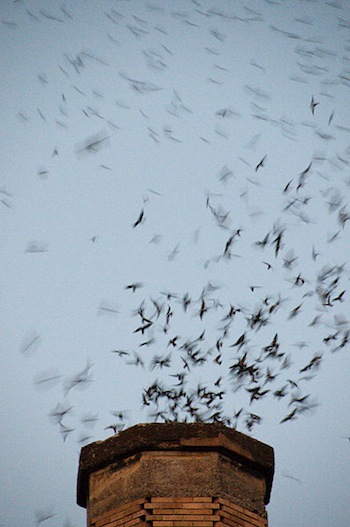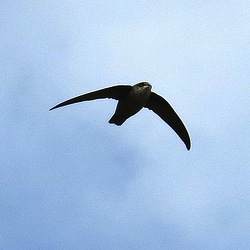 Tomorrow, I’m driving to Oregon for a friend’s wedding. While I’m there, I may get a chance to witness what has been described as an “avian tornado”: thousands of Vaux’s swifts dive-bombing a chimney at a Portland elementary school.
Tomorrow, I’m driving to Oregon for a friend’s wedding. While I’m there, I may get a chance to witness what has been described as an “avian tornado”: thousands of Vaux’s swifts dive-bombing a chimney at a Portland elementary school.
A Vaux’s swift is a petite, grayish bird with sharp swooping wings and a stubby tail. Honestly, it’s not much to look at on its own. But when the swifts amass in teeming spirals in the evening sky and then suddenly rush tail-first down a chimney, like a genie being sucked back into its bottle, it is a sight to see.
Usually, Vaux’s swifts like to nest in trees that have been hollowed out by fungal rot. But since old forests in the Northwest are disappearing, some of the birds have elected to use man-made structures instead. Inside chimneys, they huddle together to stay warm and build nests of sticks and saliva.
Vaux’s swifts swoop into Portland’s Chapman Elementary School chimney.
These unannounced guests can take people by surprise. In a 1924 paper, researchers describe an engine house in Wilsonville, Oregon where the owner “heard squeakings in the boiler and thought some bats had taken possession.” Instead, he saw a Vaux’s swift and four nestlings. To ascend the smokestack, the mother “hooked her sharp toes in the sooty side of the stack and walked right up as if she were going up a ladder.” Another researcher, who observed swifts in his chimney by lying down in the fireplace, saw pairs of birds “leap-frogging”: one flew a short distance over the other, then reattached itself to the wall, and the swifts repeated the process until they had reached the top.
Although the birds are known for their impressive aerial maneuvers, they are not uniformly graceful. Watching Vaux’s swifts plunge into a hollow fir, one scientist noted that three of the birds missed the entrance entirely and tumbled ignominiously through the branches.
 Sadly, the swifts may soon lose their secondary homes as well. Old-fashioned brick chimneys are becoming scarce, and newer metal-lined chimneys are no good for nesting. To help the birds, some scientists have constructed long, rectangular nest boxes and attached them to the sides of trees. In a 2003 study, one team found that Vaux’s swifts used about one-third of the nest boxes, and half of the nests produced fledglings.
Sadly, the swifts may soon lose their secondary homes as well. Old-fashioned brick chimneys are becoming scarce, and newer metal-lined chimneys are no good for nesting. To help the birds, some scientists have constructed long, rectangular nest boxes and attached them to the sides of trees. In a 2003 study, one team found that Vaux’s swifts used about one-third of the nest boxes, and half of the nests produced fledglings.
For those who want to see the swifts in action, the birds are expected to return to Portland’s Chapman Elementary School chimney each night for the rest of the month. The Wagner Center in Monroe, Washington, another major roosting site, is having a “Swift Night Out” this Saturday.
And if a young Vaux’s swift drops into your fireplace? Gently stick the bird onto the chimney wall, advises the Audubon Society of Portland. It’ll clamber right back up.
Image credits
First image: Kat+Sam | Wikimedia Commons
Second image: stonebird | Flickr
How do they DO that? that tornado business? Migrating geese do it too when they come in to land.
I have no idea! And I don’t understand how they all fit in the chimney. I read somewhere that the Wagner Center chimney has had as many as 26,000 swifts roosting inside at one time.
We have the same phenomenon in Baltimore,as follows: “SEP 22(Sun) 6:45-7:30PM CHIMNEY SWIFTS AT DUSK. Join the Baltimore Bird Club….We’re
expecting hundreds, even thousands of swifts…this year’s fall site will be posted on the BBC website (http:baltimorebirdclub.org) on Friday, Sep. 20. Come 1/2-hr. early.”
I wrote about a chimney full o’ swifts once! http://news.sciencemag.org/climate/2012/04/clues-species-decline-buried-pile-bird-excrement It was about scientists using the chimney full of bird poop as an archive–they took samples from it and figured out how the birds’ diet had changed over time.
I remember that story! Fun study.